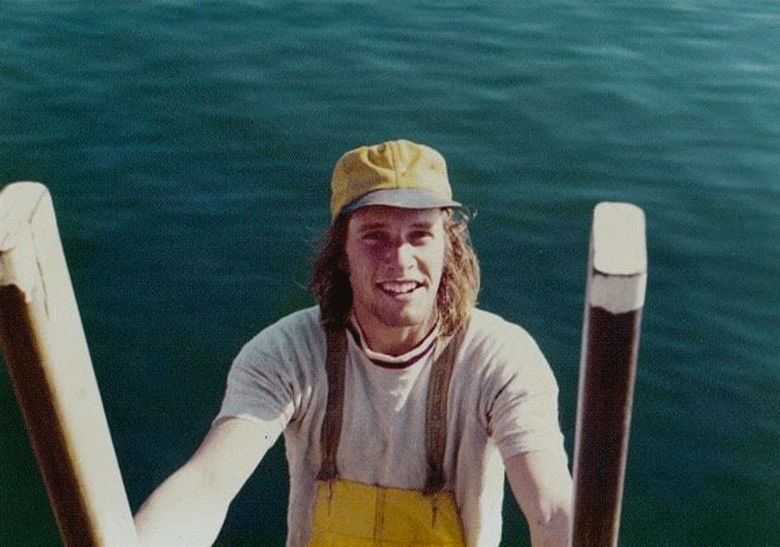A chance encounter on Cliff Island, six miles off Portland in Casco Bay, led to a conversation that yielded rich history about lobstering in the 1970s.
It started while I was scoping out the island trash and treasures that depart in early June as the “large item” pickup. Edward Reiner, known on the island as Teddy, saw me and offered me a bike he was sending off island with the trash. As he helped me change its tires, he began telling me fascinating stories from his younger days on the island. I thought, “This needs to be recorded!”
After attending Clark University, Reiner lobstered on Cliff Island for over 13 years. He went on to become a carpenter, teacher (language arts and kindergarten), storyteller, and writer.
Reiner agreed to an interview, and we met at his house late one afternoon. He sat in a rocking chair in the living room of his cottage overlooking Fisherman’s Cove, home to the island’s lobster fleet.
The interview has been edited for length and clarity.
The Working Waterfront: Tell me about how you started lobstering.
Reiner: I lobstered with Bunk MacVane for two years. It was hard work. I remember that Bunk had these 4-foot traps that weighed 90 pounds. We had long days moving those traps around. I was strong, but I got muscle bound so that my arms would not hang straight when I was standing up.
I would come home after a day of hauling, sit down in my rocking chair, and conk out for about 20 minutes. That’s how tired I was. But I really loved lobstering, and I think I was a quick learner. I was good in boats. I was learning how to rig a string of lobster traps, and how to build them.
There were many older men who were my friends. I think one of the nicest things about Cliff Island, and that part of my life, were those friendships…
And when I got out of college, I wanted to be here. So, that summer we were putting a roof on the house, and at the end of the summer Bunk asked me to be a sternman, and Bunk was one of the top lobstermen.
One of the things that helped me get into the lobster fleet was that I was a scuba diver, so I had a lot of jobs to help island lobstermen with—getting the rope untangled from their propellers, retrieving lost traps, and hauling blocks.
My brother and I were both working for Cliff Island lobstermen. So it kind of segued into me, thinking, “Well, I can do this on my own.”
So I started building traps in our island house. Pretty soon I was knitting heads for my new oak lobster traps. I think I built between 650 and 700 traps overall.
WW: How long would it take you to build a trap?
Reiner: It’s not that hard to build the oak frames but first you have to rip down the rough-cut, four-foot boards. The bow frames are 1-inch by 2-inches in size, and the laths are about half-an-inch thick and about 36 inches long.
You would try to rip-cut as many as 1,000 a day. It was very labor intensive if you include the actual milling of the wood and the cross-cutting.
Then these traps had to have the heads nailed in and tied off. We ballasted the traps with Cliff Island rocks, strapping them in with leather from the shoe industry. I also made a set up in the middle of the trap, a place to pour cement for ballasting the trap.
I would think it would be about eight hours per trap.
There’s a bait line that comes up through the kitchen end of the trap, and that was tied around a cleat that you carved with a hatchet. It was a lot of fun and I had to learn all those skills of milling the wood. I had to order the lumber, too, so that’s a business skill, right?
Knitting heads was something husbands and wives would do while sitting by the fire. I used to knit heads on the Casco Bay Lines.
I feel like a dinosaur now because few people are knitting their own heads these days. Instead of using hemp twine, the heads are now cut out of shrimp nets.

Those skills of building the traps led to me being a pretty good carpenter, and I worked doing carpentry in island homes. Even when I wasn’t on the island, I would come back for the summer and work.
There were many older men who were my friends. I think one of the nicest things about Cliff Island, and that part of my life, were those friendships with other lobstermen. We all appreciated each other. It was a fraternity, a brotherhood.
WW: How has lobstering changed over the years?
Reiner: Now the boats are more expensive. In the old days, lobstering did not require a lot of money. Almost all the boats were serviced by their owners. They usually had car engines. So all lobstermen had to be excellent mechanics. Back then the lobstermen weren’t interested in buying brand new boats with big diesel engines that cost $70,000 or $80,000, so the business has changed a lot.
One of the biggest changes in the industry is the capital investment. It used to be very minimal, but now it costs a lot to get started lobstering. Now there are half a million dollar boats out there, and instead of one stern man, they might have three stern men.
The environmental impact of the lobstering industry is also far greater. Lobster traps didn’t contain plastic netting and plastic coated steel. Lost wooden traps would eventually rot away and stop catching lobsters. The wire traps when lost become ghost traps, lost on the bottom for years, and they keep catching lobsters.
These wire traps are an environmental issue. Some 40% of ocean pollution worldwide is from lost commercial fishing gear. Maine lobstermen have not dealt with the issue of lost and storm-wrecked traps and gear. It has become a major problem along the coast of Maine.
Sometimes Maine fishing draggers often tow their nets into strings of lobster traps offshore causing thousands of dollars of damage and hundreds of traps to end up lost and permanently on the bottom of the ocean.
Kai Holloway has spent most of his 15 years living year-round on Cliff Island, and now his family returns to spend about five months in an off-the-grid cabin in the woods. He works at the Cliff Island Historical Society and is fascinated by stories of Cliff Island’s history.





